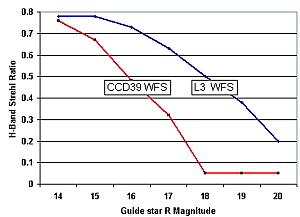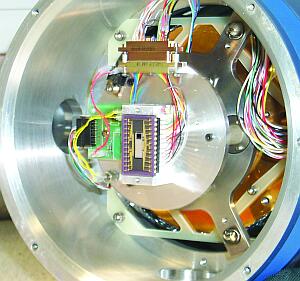L3 CCD Technology
Simon Tulloch (ING)
Low
Light Level (L3) CCD technology is a recent development from E2V that opens
up interesting new observational regimes. The technology allows production
of scientific CCDs in which the read noise of the on-chip amplifier becomes
negligibly low. Additionally, this effective zero-noise performance is decoupled
from readout speeds and the almost zero noise performance holds up to frame
rates of 1KHz. E2V achieve this by using an avalanche multiplication mechanism
in the horizontal register of the CCD. A single photo-electron entering this
register exits as a substantial charge packet; the exact gain being variable
and determined by the level of a high voltage multiplication clock. At gain
levels of around 500 it becomes possible to identify individual photon events
in the image. The downside of L3 technology is that the multiplication process
degrades the SNR at higher signals by a factor of 2
1/2 . There
is also a small additional noise contribution from spuriously generated electrons
within the device.
L3 CCDs should be useful in any observing regime currently limited by detector
noise. Wavefront sensing is an obvious application and E2V have produced
the 128×128 pixel frame transfer CCD60 with this in mind. We have purchased
one of these and are currently working on an upgrade to the Naomi WFS.
Figure 1 shows the kind of gains we can expect once this system is commissioned.
For comparison, the performance of Naomi’s current WFS, the CCD39, is also
shown.
Other applications for L3 technology are currently being evaluated on the
WHT using a cryogenic test camera in which we have mounted the CCD60 (see
Figure 2).

|

|
Figure 1 (left). Potential L3 gains
in NAOMI. Thanks to Richard Wilson for providing Figure 1 [ JPEG | TIFF ]. Figure
2 (right). The L3 Test Camera [ JPEG | TIFF ].
|
This camera was mounted on the Auxiliary port in November where we tested
its performance as a fast photometer. On the 10th we observed the Crab Nebular
pulsar and were able to directly distinguish its 30Hz variability. The camera
used its own data acquisition system based around a Linux PC and a slightly
modified SDSUII controller. This DAS combined the functions of an acquisition
TV and a science camera. This was important given the rather small 14 arcsec
field of view. Once the image was acquired, the camera switched to its fast
photometry mode in which it made a rapid sequence of 1024 windowed readouts
at a rate of 180 frames per second. The resultant image format consisted
of a ‘movie strip’ of consecutive frames, a short section of which is shown
in
Figure 3.

|
Figure 3. The Crab Pulsar indicated by the red
arrows in this series of frames. [ JPEG | TIFF ]
|
Although faint, the pulsar is visible. The red arrows indicate the frames
in which the brightness peaks. An animated GIF of these pulsar observations
can be found at:
http://www.ing.iac.es/~smt/WFS/CrabMovie.gif.
We currently have on order a larger engineering grade L3 CCD measuring 512×512
pixels. This will be incorporated into a second test camera and mounted on
ISIS where its suitability for rapid spectroscopy will be investigated .
Thanks to Durham University’s RLGS team and to Vik Dhillon for their cooperation
in the testing of this new camera.¤
Email contact: Simon
Tulloch (
smt@ing.iac.es)




